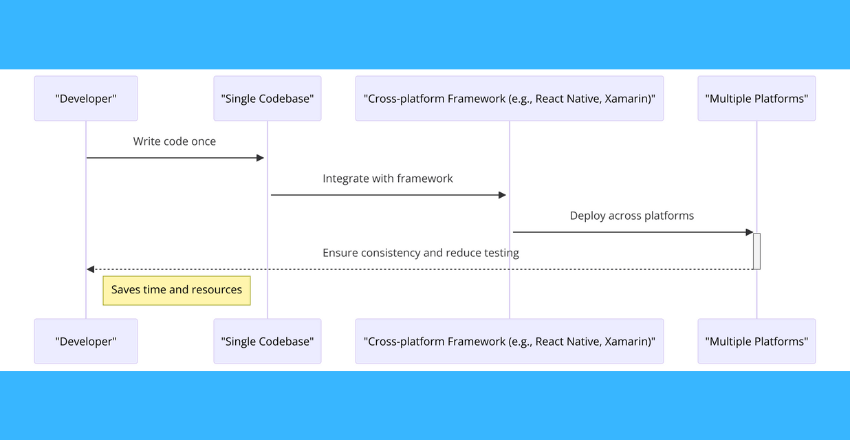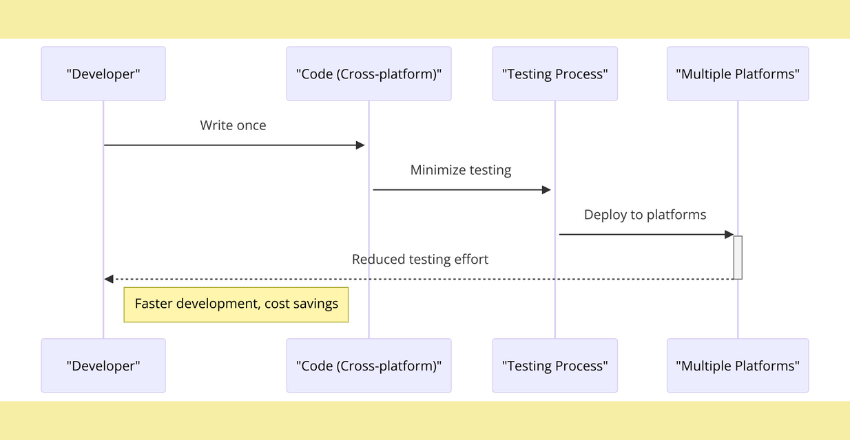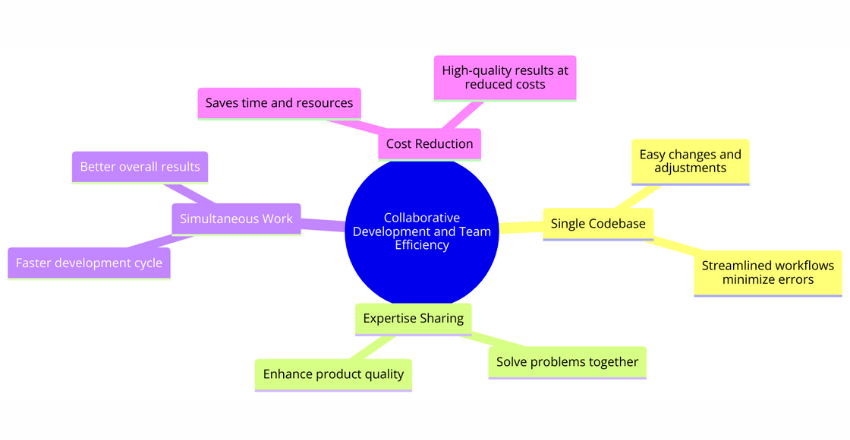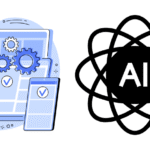
Reduce Your Development Cost with Cross Platform Solutions through streamlined workflows, simplified maintenance, and broader market reach with one development effort.
One of the most effective ways to reduce development costs is by utilizing cross-platform solutions. Cross-platform development allows developers to write code once and use it across multiple platforms, resulting in significant time and cost savings.
Efficient development is crucial to staying ahead of the competition, and cross-platform solutions offer several benefits in this regard. By streamlining development efforts, minimizing testing efforts, and optimizing performance and speed, businesses can achieve cost savings while still delivering high-quality apps that work seamlessly across multiple platforms.
Key Takeaways
- Cross-platform solutions offer cost-saving strategies that can reduce development costs.
- Efficient development is crucial to staying ahead of the competition, and cross-platform solutions offer several benefits in this regard.
- By leveraging cross-platform frameworks, code reusability, and collaborative development, businesses can achieve cost savings while still delivering high-quality apps.
Cross-platform development

Cross platform development refers to the process of building mobile and web applications that can work seamlessly across multiple operating systems and platforms. This approach enables developers to write code once and deploy it on a variety of platforms, including iOS, Android, and Windows. Efficient development through cross-platform solutions has become increasingly popular in recent years due to its cost-saving benefits and streamlined workflows.
Cross-platform development has a significant advantage of lowering development costs and improving efficiency. Developers can write code once and deploy it across multiple platforms rather than building separate codebases for each platform. This process minimizes development efforts while still maintaining compatibility and accessibility across mobile and web platforms.
Choosing the right cross-platform framework
A crucial consideration when opting for cross-platform development is choosing the right framework. Choosing a framework that maximizes development efficiency and minimizes costs is the key to efficient development. Some of the most popular cross-platform frameworks available in the market include:
| Framework | Description |
|---|---|
| React Native | An open-source framework for building mobile apps using JavaScript and React. |
| Xamarin | A Microsoft-developed framework that uses C# and .NET for building cross-platform apps. |
| Flutter | A Google-developed framework that uses Dart programming language for building apps for Android, iOS, and web from a single codebase. |
Apart from these popular frameworks, there are other options available as well – such as PhoneGap, Adobe Air, and Sencha Touch. When choosing a framework, the key factors to consider include:
- Cross-platform compatibility: Make sure the framework supports all the platforms you intend to target with your app.
- Development time: Choose a framework that helps you save time during development. Look for frameworks that offer ready-made components and modules that you can utilize to speed up the development process.
- Cost: Look for frameworks that offer a balance between development efficiency and cost.
- Community support: Opt for frameworks with an active and supportive community that can assist you in case of any issues.
By selecting the right cross-platform framework, businesses can achieve efficient development and save costs associated with developing apps across multiple platforms.
Leveraging Code Reusability to Achieve Efficient Development

One of the key advantages of cross-platform development is the ability to leverage code reusability, leading to more efficient development processes and reduced costs. By writing code once and deploying it across multiple platforms, developers can save valuable time and resources that would otherwise be spent duplicating efforts for each separate platform.
Additionally, code reusability allows for greater consistency across different platforms, ensuring that apps function seamlessly regardless of the device or operating system used. This reduces the need for extensive testing and debugging efforts, further streamlining the development cycle and saving costs.
To maximize the benefits of code reusability, it is important to select a cross-platform framework that enables seamless integration of code across different platforms. Frameworks such as React Native and Xamarin are designed specifically with this in mind, offering developers the ability to write code in a single programming language and deploy it across multiple platforms without sacrificing performance.
By adopting a mindset of code reusability, developers can achieve significant cost savings while delivering high-quality, consistent apps across various platforms.
Simplifying maintenance and updates
Keeping apps up-to-date and running smoothly is crucial for any successful business. With cross-platform development, maintaining and updating apps across different platforms is simplified, streamlining the development process and reducing costs associated with managing multiple codebases.
Instead of having separate teams and resources dedicated to maintaining and updating each platform individually, cross-platform solutions allow for a unified approach. Development teams can write code once and deploy it across multiple platforms, ensuring consistency and reducing the risk of errors or discrepancies between versions.
The convenience of cross-platform development also extends to app updates. Instead of updating each platform separately, a single update can be made for all platforms, saving both time and resources. This allows companies to respond quickly to user feedback, fix bugs, and roll out new features more efficiently.
Streamlining UI/UX Design
One of the major benefits of cross-platform development is the ability to create a unified user experience (UX) across all platforms. This is especially important considering the increasing number of devices and platforms available in the market. With cross-platform solutions, designers can work on creating one UI/UX design instead of creating individual designs for each platform separately.
Not only does this streamline the design process, but it also saves time and resources. By designing once and deploying to multiple platforms, businesses can achieve significant cost savings, which is a key component of cost-saving strategies. Additionally, this approach ensures consistency in the user experience, which is essential in building brand recognition and customer loyalty.
Minimizing testing efforts

Cross-platform development allows developers to create applications that work seamlessly across multiple platforms. This eliminates the need for extensive testing across each platform, resulting in significant time and cost savings. With cross-platform solutions, developers can write code once and deploy it to multiple platforms, reducing the need for redundant testing efforts.
By minimizing the testing process, cross-platform development enables faster development cycles and more efficient use of resources. Developers can focus on optimizing application performance and user experience without worrying about individual platform compatibility issues. This results in faster time-to-market, improved user satisfaction, and reduced development costs.
Optimizing Performance and Speed
One of the critical benefits of cross-platform development is the ability to optimize performance and speed. In the early days of cross-platform solutions, developers faced challenges regarding performance and speed. However, modern cross-platform frameworks have overcome these limitations, offering excellent performance and speed across different platforms. This optimization contributes to an efficient development process and cost-saving strategies.
By leveraging cross-platform development, developers no longer have to deal with the tedious task of writing platform-specific code. Instead, they can focus their efforts on writing efficient code that works seamlessly across multiple platforms, resulting in faster and better app performance. Additionally, modern cross-platform tools boast native-like performance, offering users a smooth and immersive experience.
Moreover, with cross-platform development, there is no need to maintain multiple codebases, which can significantly reduce the risk of errors occurring. As a result, teams can dedicate more time to optimizing performance and speed, leading to better app quality and faster development cycles.
Cross-platform development is a powerful tool for optimizing performance and speed, allowing developers to create high-performing apps that run seamlessly across multiple platforms. By leveraging this technology, companies can save time and resources, improve app quality, and ultimately, reduce development costs.
Collaborative Development and Team Efficiency

Cross-platform development encourages collaboration among team members, leading to improved efficiency and reduced costs. By working together on a single codebase, developers can easily make changes and adjustments that benefit the entire team. Moreover, streamlined workflows minimize errors, ensuring the development process is efficient and effective.
In a collaborative development environment, team members can offer their expertise to solve problems and enhance the quality of the end product. This can save valuable time and resources, allowing for a faster development cycle. Finally, team members can work simultaneously on different aspects of the project, leading to better overall results.
By promoting collaboration and team efficiency, cross-platform development can reduce costs and deliver high-quality results. It is a cost-saving strategy that every company should consider to stay competitive in today’s market.
Addressing Platform-Specific Requirements
One of the common concerns with cross-platform development is the compatibility with each platform’s unique features and functionalities. However, cross-platform frameworks have evolved to address these platform-specific requirements, while still maintaining cost-saving advantages.
Developers can use platform-specific APIs and plugins to access native features of each platform, ensuring that the app works seamlessly on all devices. This approach eliminates the need to create platform-specific codebases, saving development time and resources.
Outsourcing cross-platform development
Outsourcing cross-platform development is a cost-saving strategy that businesses can implement to reduce their development costs. By partnering with a reliable outsourcing provider like Hire Cross Platform, companies can benefit from access to expert cross-platform app developers from South America, known for their cost-effectiveness and high-quality results.
Outsourcing cross-platform development offers several benefits, including reduced labor costs, faster development cycles, and access to a broader pool of talent. By outsourcing, businesses can focus on their core competencies, while the outsourcing provider takes care of the technical details.
At Hire Cross Platform, our cross-platform developers have extensive experience developing apps that work seamlessly across multiple platforms. They are proficient in various cross-platform frameworks and tools and can help businesses choose the most suitable option that maximizes development efficiency while minimizing costs.
Outsourcing to Hire Cross Platform also includes access to a highly collaborative development team that is committed to delivering high-quality results. Our team members work closely with our clients to ensure that all development efforts align with their business goals, resulting in streamlined workflows, reduced errors, and ultimately, lower development costs.
Wrapping Up

By adopting cross-platform solutions, businesses can significantly reduce development costs while still achieving high-quality results.
Through cross-platform development, teams can leverage code reusability, streamline UI/UX design, simplify maintenance and updates, and minimize testing efforts. Additionally, collaborative development promotes team efficiency, while optimizing performance and speed.
Companies can also benefit from outsourcing cross-platform development to Hire Cross Platform, which offers skilled cross-platform developers from South America at competitive rates.
About Hire Cross Platform
Hire Cross Platform is a leading provider of cross-platform app developers from South America. Our team consists of highly skilled professionals who are passionate about delivering cost-effective and high-quality results.
We understand the importance of cross-platform development in reducing development costs and promoting efficient development. Our developers are experts in various cross-platform frameworks and are equipped to handle all types of platform-specific requirements.
At Hire Cross Platform, we prioritize collaboration and team efficiency to ensure that our clients receive the best possible service. Our competitive rates and expertise have helped numerous companies reduce their development costs through successful cross-platform development projects.
External Resources
https://en.wikipedia.org/wiki/Collaborative_development_environment
https://support.google.com/googleplay/answer/113412?hl=en
FAQ

FAQ 1: How can cross-platform development significantly reduce overall development costs?
Answer: Cross-platform development allows developers to write a single codebase to create applications that run on multiple platforms, such as iOS, Android, and the web. This approach eliminates the need to develop separate applications for each platform, thereby reducing the resources and time required. By sharing code across platforms, businesses can save on development, testing, and maintenance costs.
Code Sample:
Consider a simple example using Flutter, a popular cross-platform framework, to create a mobile application with a shared UI and logic for both iOS and Android:
import 'package:flutter/material.dart';
void main() => runApp(MyApp());
class MyApp extends StatelessWidget {
@override
Widget build(BuildContext context) {
return MaterialApp(
home: Scaffold(
appBar: AppBar(title: Text('Cross-Platform App')),
body: Center(
child: Text('Write once, run everywhere!'),
),
),
);
}
}Explanation: This Flutter application demonstrates how a single codebase can provide a consistent user experience on both iOS and Android platforms. Flutter compiles to native code, ensuring that the performance is comparable to native applications while significantly reducing development and maintenance efforts.
FAQ 2: What are the cost-effective benefits of choosing cross-platform development for startups?
Answer: For startups, budget constraints are a common challenge. Cross-platform development offers a cost-effective solution by enabling startups to target multiple platforms without the need for hiring separate development teams for each platform. This approach not only speeds up the time to market but also ensures that limited resources are used efficiently, maximizing the return on investment.
Code Sample:
Using React Native, here's how you can create a responsive button component that works on both iOS and Android:
import React from 'react';
import { Button, View } from 'react-native';
const MyButton = () => (
<View>
<Button onPress={() => alert('Button Pressed!')} title="Click Me" />
</View>
);
export default MyButton;Explanation: This example showcases how React Native allows for creating UI components that behave consistently across multiple platforms. The Button component will render using native controls on both iOS and Android, providing a native look and feel while keeping development costs low.
FAQ 3: How does cross-platform development streamline the update and maintenance process, contributing to cost reduction?
Answer: With cross-platform development, updating your application or fixing bugs becomes much more straightforward since changes need to be made in only one codebase. This unified approach significantly reduces the time and cost associated with maintaining and updating applications, as opposed to managing separate codebases for each platform.
Code Sample:
Here’s an example of a cross-platform update function in a Xamarin.Forms application:
public void UpdateAppFeature(string featureName, bool isEnabled)
{
// Update feature flag across all platforms
Application.Current.Properties[featureName] = isEnabled;
Application.Current.SavePropertiesAsync();
}Explanation: In this Xamarin.Forms code snippet, a feature’s enablement state is updated across all platforms using a single method. This approach simplifies the process of rolling out new features or fixing issues, as the same piece of code affects every platform the application runs on, thereby streamlining maintenance and reducing costs.

Charlotte Williams is a talented technical author specializing in cross-platform app development. With a diverse professional background, she has gained valuable experience at renowned companies such as Alibaba and Accenture. Charlotte’s journey in the tech industry began as a mobile UX designer back in 2007, allowing her to develop a keen understanding of user-centric app design.
Proficient in utilizing frameworks like React Native and Flutter, Charlotte excels in building cross-platform mobile apps and imparting her knowledge to aspiring developers. She pursued a degree in Computer Science at Cornell University, equipping her with a strong foundation in the field. Residing in San Francisco with her three beloved dogs, she finds solace in hiking the hills and connecting with nature. Charlotte’s passion for app development, combined with her dedication to sharing expertise, makes her an invaluable resource in the world of cross-platform app development.






